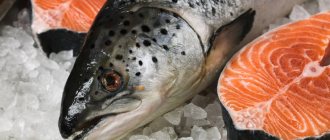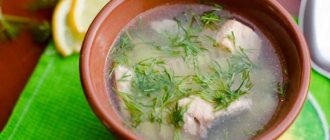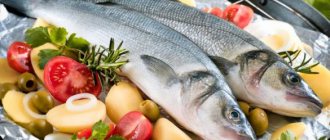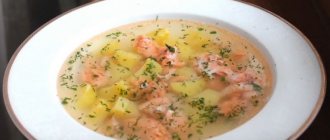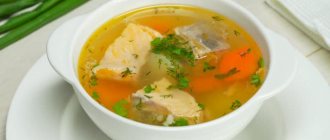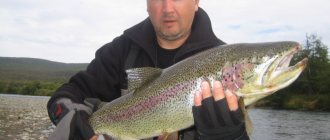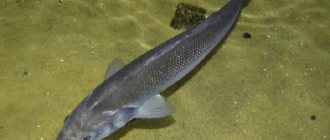What does coho salmon look like and where did it come from?
Coho salmon are predators and live in oceans, lakes and seas. Fish meat contains many useful elements, vitamins and minerals.
In Russia, it can be found in the north of the country in Magadan, Sakhalin and Kamchatka. She prefers the Pacific Ocean, or rather its northern part. It is especially prized for its tasty meat and small amount of bones. The fish belong to the salmon family; they are almost impossible to distinguish from other representatives of this family.
Coho salmon are a rare breed, so enterprising entrepreneurs raise this species on their farms . Even though it is used to cold waters, it has learned to grow in southern countries such as Chile. Only in size and weight are fish from artificial reservoirs worse than salmon that grew in their natural environment.
The northern representative of salmon rarely exceeds 90 cm in length. It is usually 80 cm long and weighs no more than 7 kg.
It was because of its silvery and beautiful scales that the Russians called it “white fish”, and the Americans and Japanese called it “silver salmon”. It differs from other representatives of salmon by its large head with a wide forehead. Has an impressive tail size, but the fins are quite small and do not match the size and weight.
The meat is fatty. When compared to other members of the family, only sockeye and chinook have a higher fat percentage. It is similar in taste and nutritional properties to salmon. Fish is easy to cook, the result exceeds all expectations. Tender, almost boneless meat is allowed for diabetics and overweight people . It can be eaten on its own, served with toppings, or as an addition to multi-ingredient dishes such as soups.
How does coho differ from other salmon?
At first glance, it is difficult to distinguish coho salmon from other members of the salmon family. But there are certain features. Let's look at them.
From chum salmon
The main difference between chum and coho salmon is size. If chum salmon can reach a length of 100 cm or more, then coho salmon, in comparison, does not exceed 90 cm. And in terms of weight, the maximum indicators for chum salmon are 14 kg, and for coho salmon - 7 kg.
A characteristic feature of silver salmon may be the color of its scales during spawning. It gets a light raspberry tint, but chum does not.
Chum salmon differs in taste due to its caviar and its size. Chum salmon eggs are large and not bitter. There are also differences in the color of the meat: chum salmon is light, coho salmon is bright red.
It's worth knowing! Despite its small size and bitter taste, silver salmon caviar has an advantage over other salmon in terms of nutritional value and is a leader among them.
From pink salmon
If you compare them, it is worth noting that its meat is a little, but still thicker. There is practically no difference in the value of use and calorific value between representatives of salmonids. The only advantage of pink salmon is that it contains more B vitamins and some trace elements such as copper, iodine, manganese, selenium and cobalt.
From salmon
“White fish” differs from salmon mainly in size and variety. Coho salmon prefer the Pacific Ocean, and salmon prefer the Atlantic. The maximum size of Atlantic salmon is 1.5 m and its weight is 40 kg. However, silver salmon cannot boast of such sizes.
The difference is in the color of the meat: salmon is slightly orange, coho salmon is red. If you compare the beneficial and nutritional qualities, it is safe to say that they are equivalent.
From trout
A characteristic feature of a trout may be the color of its scales . It has a silver tint with a pink stripe on the sides. Bright black spots are located throughout the body of the fish. Silver salmon has a bright, beautiful color with silver. Trout are smaller in size than coho salmon. He is slightly smaller than his brother, both in length and weight.
If trout is grown mainly in artificial aquariums, then coho salmon is a free fish. Therefore, the meat tastes more tender and tastier than trout.
From sockeye salmon
Coho salmon have fewer gill rakers. Size and weight less than sockeye salmon. Both species are rare breeds of salmon, so their fishing requires the consent of the relevant authorities.
The difference can be distinguished by the taste of the meat. Sockeye salmon has a specific taste, harder than silver salmon. In terms of body condition, sockeye salmon is better than coho salmon, but not by as much. From a performance point of view, both representatives contain a full range of vitamins, minerals and trace elements necessary for the functioning of the body.
Worth knowing! Sockeye salmon and coho salmon meat are allowed for diabetics and overweight people, but are contraindicated for patients with kidney and digestive problems.
Coho salmon or sockeye salmon: let’s figure out which is tastier together
Buying red fish is a choice between several varieties. But not everyone can tell which is better: chum salmon or coho salmon, sockeye salmon or salmon. To buy what you need, you need to clearly understand the difference between the types.
Taste
Despite the similarities, different varieties of red fish have different characteristics, biochemical composition, nutritional value and quality. The pulp varies:
- fat content;
- tenderness of muscle fibers;
- more delicate or, conversely, pronounced taste qualities;
- composition of valuable elements - Omega-3 fatty acids, amino acids, minerals, vitamins.
Therefore, in order to make the right purchase, let’s consider the difference between the highest quality representatives of red fish species, which are these 2 varieties of salmon.
Speaking of taste, it is worth noting the following features of the meat of these two types of salmon:
- Chum salmon has several subspecies, but despite this, its taste, quality and other characteristics remain almost identical. The meat of this fish has a slightly grayish tint, that is, it lacks that bright red color that the consumer is accustomed to seeing in other salmon species. Protein fibers are dry. Therefore, it is best to salt this fish, just like pink salmon. It is in this form that it tastes best.
- Coho salmon has more tender meat that is suitable for different cooking methods. This species of fish does not breed in captivity. Therefore, it does not have artificial antibiotics and other harmful components that accumulate in meat during artificial cultivation. This is a delicious fish with a slight bitter taste.
Which one is fatter?
Comparing the fat content of both fish, the difference is not significant:
- Thus, chum salmon contains about 5.6 g of unsaturated fatty acids for every 100 g of muscle fiber weight.
- Coho salmon. It is very difficult to distinguish 2 fish by this parameter, since when fresh it contains 5.93 g of unsaturated fatty acids.
But still, from a comparison of this parameter, chum salmon is drier, which requires taking this parameter into account during cooking. Therefore, if you want fattier fish, which will be cooked on coals, on the grill, in the oven, then coho salmon will turn out to be tastier due to the fact that it is fattier. But the difference is still insignificant.
Differences in KBZHU
It is interesting to compare chum salmon and coho salmon in terms of calorie content and nutritional value.
The KBJU of chum salmon is:
- Calorie content – 127 kcal.
- Proteins – 19 g.
- Fats – 5.6 g.
- Carbohydrates – 0 g.
KBZHU for coho salmon are in the following range:
- Calorie content – 140 kcal.
- Proteins – 21.6 g.
- Fats – 6 g.
- Carbohydrates – 0 g.
Comparing these parameters, it is worth noting that due to the smaller amount of fat in chum salmon, it becomes drier. It also differs in that it contains less protein compared to coho salmon.
Main differences
Comparing chum salmon and coho salmon, we can highlight the following parameters by which these 2 types of fish differ:
- Coho salmon is higher in calories due to its higher fat content.
- If you want to get more proteins, then buy coho salmon.
- Both fish are large in size; small specimens are extremely rare. But finding coho salmon or sockeye salmon weighing more than 14 kg on sale is also very difficult. Chum salmon is most often sold as a whole carcass and weighs about 4-5 kg. Coho salmon are slightly larger, about 5-7 kg.
- Considering the prevalence, it is chum salmon that has the largest one, since its fishing is much wider, and it is also grown in artificial conditions.
- Coho salmon is a fish that is not raised in cages, just like sockeye salmon. It is caught exclusively in the wild, so it is better than all other types of salmon - salmon, which are grown industrially. After all, it is this parameter that allows you to be confident in the environmental friendliness of the fish. Coho salmon, like sockeye salmon, are fish highly valued by gourmets due to their nutritious meat or rich mineral composition. They have a slight piquant bitterness.
- The price of coho salmon is higher than that of chum salmon. This is due to the population and distribution area of the fish.
But, despite this difference, everyone will choose the most suitable fish for themselves, both in terms of taste and a number of other characteristics.
Difference from pink salmon
If you compare chum or coho salmon with pink salmon, the following facts become obvious:
- Pink salmon has the driest meat of all salmon species, despite almost the same content of proteins, fats and calories. Thus, pink salmon contains 20.5 g of protein for every 100 g of meat weight. Fat - 6.5 g, and calories - 140 kcal, like coho salmon.
- Pink salmon is a common fish in terms of habitat. Therefore, its price is lower compared to other types of red fish - coho salmon, chum salmon or sockeye salmon.
What is more suitable for pickling
When choosing what is best to salt, it is still better to choose chum salmon.
This is due to the fact that it contains a lot of water and a little fat. In addition, the structure of the protein is such that during heat treatment it becomes excessively dry and hard. Therefore, it is always better to salt this fish. This way the meat turns out tender, quite juicy and retains its consistency and structure. In addition, the pieces remain intact when cut.
But coho salmon is also tasty when salted. The only thing that needs to be taken into account is the need to add more salt than when preparing chum salmon. This is due to the fact that fatty fibers absorb salt less readily.
Here it makes sense to say that when choosing a cooking method, it is still better not to heat treat chum salmon. It will taste best when salted. But coho salmon can be baked, salted or fried. It will be equally good in any form. Therefore, the choice depends on preference.
Which is healthier?
Considering the biochemical composition, it is worth highlighting that chum salmon contains:
- Vitamins of group B1, B2, A, D, E.
- Of the micro- and macroelements, iron, phosphorus, chromium, nickel, molybdenum and fluorine are the most abundant here.
Thanks to this, its benefits for the body:
- Helps the active functioning of the brain, including cognitive activity, reaction speed, memory. Moreover, this effect is expressed both in children and in the elderly.
- Thanks to a large amount of phosphoric acid, the skeleton is strengthened.
- Prevents the development of thrombosis and atherosclerosis.
- Reduces the intensity of inflammatory processes.
- Effectively improves blood rheology, increases the elasticity of blood vessels and prevents their ruptures.
But it is necessary to take into account that chum salmon, like any other red fish, can cause an allergic reaction. Therefore, it is necessary to carefully introduce it into the diet of those people who are prone to allergies. But its value is so high that it is recommended in nutrition from early childhood.
Speaking about coho salmon, it is worth highlighting the following features:
- There is a lot of vitamin B2, B3, PP, C, A.
- Of the micro- and macroelements, it is worth highlighting - sodium, potassium, molybdenum, zinc, iron, calcium, nickel, chromium.
Describing the overall positive effect on the human body, the following features can be highlighted:
- Normalizes the functioning of the central nervous system.
- Has a beneficial effect on mental activity.
- Causes increased hemoglobin production.
- Reduces visceral fat deposits.
- Has a beneficial effect on the elasticity of blood vessels.
- It has a positive effect on the entire bone and cartilage system.
- Strengthens the body's immune forces.
- Due to the presence of such a rare substance as astazanthin, it has an antioxidant effect on the body. In this way, the body removes radionuclides, salts of heavy metals, and other toxic substances.
- Iodine in the composition has a beneficial effect on the functioning of the thyroid gland.
As can be seen, the impact of the two fish species is similar. But chum salmon and coho salmon have their own characteristics.
When talking about contraindications or possible harm from eating coho salmon meat, you should limit it in case of pregnancy and breastfeeding.
And then, this does not mean the complete exclusion of meat, but only the absence of too much of it in the diet.
In moderation, red fish will only bring benefits, given that it is of high quality and caught in environmentally friendly regions. Specimens that are bred in captivity are not the best option for consumption.
In all other respects, both types of fish have the most beneficial effect on the body. Therefore, it is worth introducing them into the diet. The only thing that should be taken into account is that salted fish causes excessive accumulation of fluid in the body. And this, in turn, forms swelling.
Therefore, it is necessary to observe moderation when consuming salted chum salmon or coho salmon.
( 1 rating, average 5 out of 5 )
Source: https://moreprodukt.info/rechnye-ryby/kizhuch-ili-nerka
Ingredients and calories
Coho salmon meat is classified as a dietary element. The calorie content of 100 g of fillet is 140 kcal. After baking, this amount can increase to 200. The composition of coho salmon is rich in vitamins, minerals and trace elements, which explains the value of silver salmon.
It is worth paying attention to the balanced ratio of LBR per 100 g:
- squirrel - 24;
- fats - 8:
- carbohydrates - 0.5.
Among the vitamins:
- group B;
- ascorbic acid;
- A;
- a nicotinic acid;
- E etc.
Among the useful elements:
- calcium;
- fluorine;
- phosphorus;
- iron;
- potassium;
- zinc;
- sodium, etc.
Saturated omega-3 fatty acids are recognized as valuable substances in coho salmon meat.
Salmon: composition and calorie content
Salmon or Atlantic (lake) salmon, as this representative of the salmon family is also called, is found in the cold waters of the Atlantic Ocean or lakes of the Northern Hemisphere.
The size of the fish sometimes reaches one and a half meters, and the weight can be up to more than 40 kilograms. Tender, tasty pink meat puts the product in the category of delicacies.
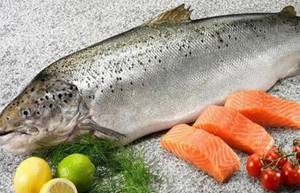
The meat of this delicacy contains:
- Squirrels.
- Fats.
- Amino acids.
- Vitamins A, B1, B2, C, E, PP.
- Fatty acids (including Omega-3).
- Potassium.
- Sodium.
- Phosphorus.
- Calcium.
- Iron.
- Methionine.
Due to its low calorie content (only 200-220 Kcal), salmon meat is considered dietary. The methionine content makes the product unique in its benefits.

Useful properties of coho salmon
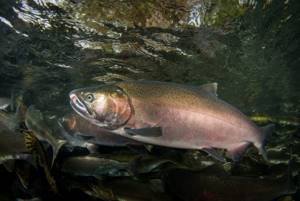
Overall benefit
Let us list the main beneficial properties of “white fish”:
- normalizes the functioning of the central nervous system;
- activates brain function;
- prevents the development of cancer;
- strengthens blood vessels;
- normalizes hemoglobin;
- reduces the risk of strokes and heart attacks;
- increases immunity;
- strengthens tooth enamel;
- normalizes the functioning of the thyroid gland;
- has a positive effect on vision;
- promotes the development and strengthening of bone and muscle tissue, etc.
Important! Coho salmon meat contains a powerful antioxidant - astaxanthin, which eliminates the presence of heavy metals and radionuclides, which prevents the development of cancer.
For women
Fish contains many useful substances that a woman needs. Thanks to regular consumption of coho salmon, you can improve the structure of your hair, strengthen your nails, and refresh your skin. Fish meat will help normalize the nervous system, activate metabolic processes in the body, and improve sleep.
For men
Men can also use coho salmon. Due to the composition of the fish:
- it strengthens muscles and bone tissue;
- increases efficiency;
- reduces the risk of cardiovascular diseases;
- increases the body's protective functions, etc.
During pregnancy
Dietary meat is recommended for pregnant women in moderation. Like other products, it should not be overused. White fish has everything necessary for the proper development and growth of the fetus.
Meat will help women recover after giving birth. Thanks to the included beneficial elements, they strengthen the nervous system, relieve fatigue and normalize sleep.
During feeding
Women who are breastfeeding should be careful when using this fish to avoid allergies. You can try a small amount of meat first and monitor your baby's reaction. If all is well, meat can be included in the diet.
Coho salmon promotes the proper development of bone and muscle tissue and strengthens bones. Thanks to the vitamins and microelements contained in meat, the child will have normal mental development. The vitamin complex will give your child strong teeth and hair.
A woman needs recovery after childbirth, so using silver salmon will help.
For children
“Northern fish” can be given to children without fear of choking from the bones. There are practically no small bones in the fillet, so the finished parts of the tenderloin will not only delight your children, but it will also be beneficial for the development of the body.
It is known that coho salmon meat due to its composition:
- improves memory and mental performance;
- strengthens bones, nails, teeth, hair;
- strengthens the immune system;
- helps improve and maintain vision;
- helps normalize metabolic processes in the body, etc.
In losing weight
Since silver salmon meat is a dietary product, it is recommended for overweight people and those on a diet. There are almost no carbohydrates in fish, there is a small amount of fat, so do not be afraid of excess weight. Fish dishes cannot be called high-calorie. They are prepared for people on a no-carb diet. This will satisfy your hunger and get rid of excess weight.
For gout
Medical advice is required before introducing coho salmon into the diet. The meat cannot be called very fatty, but there are still concerns that such fish, despite its beneficial properties, will have a negative impact on the patient’s health.
If you decide to eat “northern fish” from time to time, you should steam it. No salted or fried meat!
For gastritis
For diseases such as gastritis, it is better to give up fish or cook meat, taking small quantities. In any case, professional advice is required.
Harm and contraindications
If fish is eaten in moderation, it will not harm. It will only be useful. But, despite this, there are categories of sick people who should refuse coho salmon or limit its quantity.
Contraindications:
- hypersensitivity to fish proteins or seafood;
- allergic reactions;
- gastritis and ulcers;
- liver and kidney pathologies;
- hepatitis.
Contraindications and precautions
Despite the incredible degree of benefits of coho salmon fish, the harm from its consumption can also be felt if you do not know some of the nuances. In particular, during pregnancy, doctors advise limiting the presence of any red fish in the diet as much as possible, especially smoked and salted ones. However, a small piece of coho salmon can help stop toxicosis due to its high content of vitamin B6, although chum salmon “distinguished itself” much more strongly here. And in the second trimester, the expectant mother can also benefit from the fat contained in all Salmon.
Doctors put forward serious contraindications to eating coho salmon mainly to people with:
- gastritis;
- liver diseases in the acute stage.
The rest can include coho salmon in your diet without fear, however, if you have not tried it before and have not eaten red fish at all, start with a small portion, because An individual negative reaction from the digestive system cannot be ruled out. This is especially important for children, whose menu is just beginning to expand.
How to select and store
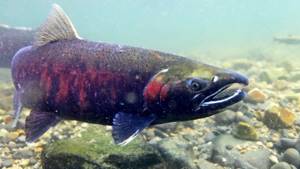
In order for fish to delight with its taste and benefit the body, it must be chosen correctly when purchasing. Knowing the criteria to follow will never let you down:
- Fresh fish always has shiny scales. The skin should fit tightly to the meat. There should be no stains, damage or bruises.
- The carcass may be a little damp, but it should not stick to your hands.
- Look at her eyes if possible. If they are cloudy, it is better not to take the fish.
- If you choose steaks, look at how they are stored. Normal storage and warehousing should take place on ice.
- Click on the carcass and look at the result. If, after pressing, it quickly restores its shape, it’s good; if the hole remains, the fish is not fresh.
Salted fish can be stored in the refrigerator for no more than a week. The carcass should be frozen for longer storage. To do this, the fish should be cleaned, wrapped in foil and placed in the freezer.
How to clean and cut coho salmon
Whole fish in the store is much cheaper, so you need to learn how to cut it yourself at home:
- The process is gradual. If the fish is frozen, we will defrost it.
- We make an incision on the stomach and remove the insides.
- We remove the fins to avoid cutting your hands when cleaning.
- We take a special knife and begin to clean the fish scales from the tail. We do this using a simple grater. If it sticks tightly to the skin, you can put the carcass in boiling water for a few seconds.
- Cut off the head. It can be useful for making broth, so make sure the gills are removed.
- We wash the carcass and cut it into pieces if necessary.
- To prepare the fillet, remove the bones with tweezers and carefully cut the meat with a sharp knife.
Description
The body, wide at the dorsal fin, tapers sharply towards the large head and tail. The tail is short, unlike other salmon. In the large mouth of fish that go to spawn in rivers, there are small sharp teeth. The color of the body is silvery-white. The scales are small, tightly adjacent to the skin. Fins are gray.
Silver salmon is usually sold canned, salted or frozen. When purchasing, keep in mind that frozen coho salmon should look the same as in photographs of live fish.
| Affiliation | |
| Family | Salmonidae |
| Genus | Pacific salmon |
| Squad | Ray-finned |
| Where is it found? | |
| Ocean, sea | Pacific Ocean, Sea of Okhotsk, Sea of Japan |
| Rivers for spawning | Rivers and streams of Kamchatka - the main herd |
| Habitat in the sea | Ocean area near the Aleutian Islands |
| Habitat for spawning in rivers | Clean, rocky areas of rivers and streams |
| Habitat | Salty sea and river fresh water |
| What does it eat? | |
| In the sea | Crustaceans, squid, small fish |
| In a river | Juvenile period – insect larvae, plankton. Spawning period - does not feed |
| Weight, dimensions | |
| Weight: fishing-maximum | 3-5 kg – 12-15 kg |
| Body length: commercial-maximum | 50-70 cm – 80-90 cm |
According to the time of spawning on the Kamchatka Peninsula, there are three forms of migratory coho salmon:
- Summer. Spawns from late August to November.
- Autumn. Spawning from early November to New Year.
- Winter. Spawning from January to early March.

Cutting coho salmon before cooking
In the second or third year of life, the juveniles slide into the ocean, where they live for a year and a half. In some lakes of the Magadan region, coho salmon form a sedentary dwarf form.
How to cook delicious coho salmon: recipes
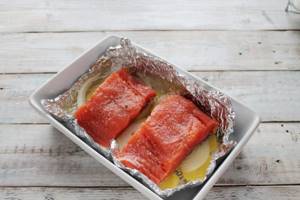
In the oven
Let's make fish in cream sauce. This recipe can be mastered even by amateurs who have never cooked it. The meat turns out especially tender and tasty. You can change the recipe according to your preferences. For example, don't use spices or add more herbs.
You will need:
- coho salmon meat - 1.5 kg;
- heavy cream, at least 20% - 250 ml;
- onion - 2 pcs.;
- salt - 1 tsp;
- hard cheese - 130 g;
- ground pepper (black) - 0.5 tbsp. spoons.
Preparation:
- Clean the fish, remove the insides, wash and dry with paper napkins or a towel.
- Cut the fish into pieces. Sizes are medium (1.7 cm). Add salt and pepper. Add spices if necessary.
- Peel the onion and cut it into half rings.
- Remove the pan, lightly grease it with oil and place chopped onion on the bottom.
- Place salted coho salmon pieces on it.
- Fill with cream.
- Preheat the oven to 180°C and bake for 20 minutes.
This recipe has two cooking options: with and without foil. If you want a baked version, cook it over an open fire. If you want to store the sauce, cover the top with cling film. Next, grate the cheese on a grater with large teeth and sprinkle on the prepared dish.
Cutlets
The recipe for fluffy cutlets will appeal to children, women during breastfeeding, elderly and pregnant women. For a healthy person, such a delicacy can be prepared every day. A distinctive feature of these chops is that they remain tasty even when chilled. You can cook them and take them to work for lunch.
You will need:
- fish meat - 1.4 kg;
- onion - 2 pcs.;
- chicken egg - 2 pcs.;
- mayonnaise - 4 tbsp. l.;
- hard cheese - 90 g;
- starch - 4 tbsp. l.
- salt - 2 tbsp. l.;
- sunflower or olive oil - 140 g;
- fish spices - if necessary.
Preparation:
- Cut the prepared and thawed carcass into pieces.
- Peel the onion and grate it using a large-tooth grater. Add it to the minced meat and stir.
- Add mayonnaise and knead the minced meat. Leave it in the refrigerator for 60 minutes to set.
- After this time, remove them from the refrigerator, break the eggs into minced meat and, if necessary, add spices.
What is Chinook salmon?
Due to its outstanding size, chinook salmon (in the Itelmen dialect - “ch'uch'u”) are often called princely or king salmon, which is reflected in the official American name of the taxon - King Salmon. Excellent gastronomic qualities and active resistance when fishing have made it a popular object of commercial, sport and recreational fishing. This fish of the salmon family leads an anadromous (anadromous) lifestyle with pronounced river and oceanic phases.
The only spawning, development of eggs, emergence of fry (parts) and growth of juveniles (from 3-4 months to 1-2 years) occur in fresh water. Full maturation, formation of reproductive function and feeding of the main mass is carried out already in the marine environment. But there are exceptions - some males do not leave the river, forming a residential dwarf subspecies that acquires the ability to reproduce at 2-3 years with a small size of 12-45 cm.
The life expectancy of Chinook salmon is quite short, only 4-8 years. This is due to fatal hormonal changes in the body during the pre-spawning period. Over the course of 1-2 weeks, all producers who took part in the spawning process completely die.
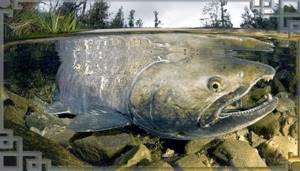
Where does it live?
The original territories of residence of king salmon in Russia are the Arctic Ocean basin, the Barents and Okhotsk Seas, the Commander Islands, Amur, Anadyr, Chukotka, and the Kamchatka Peninsula. In the USA, Canada and Japan, the species lives in the Sacramento and Coppermine basins, near northern Hokkaido, the Aleutian Islands, Alaska, Cape Krusenstern, and the Kent Peninsula. Freshwater bodies in this area are characterized by low temperatures, sparse vegetation, and poor plankton and benthos. The shortage of food supply was the main reason that forced the fish to go out to feed in the sea.
She has developed a special hypo-osmotic mechanism that allows her to easily adapt to life in water of any salinity. Chinook salmon thrive both in desalinated estuaries and bays, and in the open Pacific Ocean several thousand kilometers from the coast. At the same time, the reproductive function remained unchanged - the development of eggs occurs exclusively in the conditions of flowing cool rivers with a pebble or rocky bottom.
In order not to create food competition for growing juveniles and future offspring, during the pre-spawning period the salmon's gastrointestinal tract irreversibly atrophies, the place of which is taken by an additional volume of eggs and milt.
Contraindications for eating coho salmon
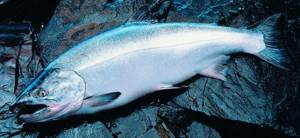
Coho salmon is a very fatty fish, and should not be consumed if you have liver disease, gastritis or allergic reactions. It is better to avoid white fish for people with kidney failure, cholecystitis, hepatitis and gastric ulcers.
Pregnant women in the early stages can eat this fish, but in limited quantities. It is better to refuse it in the last stages of pregnancy and during breastfeeding.
Conclusion
There are no exact indicators which fish is better: coho salmon or salmon. Taste qualities cannot be a sufficient reason to make a choice towards one of them, since there are approximately equal numbers of lovers of these delicacies.
If you put their beneficial qualities and possible harm on the scales, then we can say that both types are equivalent . A piece of delicacy, prepared in compliance with technology and taking into account existing contraindications, should bring not only gastronomic pleasure, but also tangible health benefits.
Fishing for coho salmon
Among Americans, fishing for coho salmon is very popular; it arouses sporting interest, because... Among the fish of its family, it shows great resistance and activity when it comes to survival. They fish for this species on Sakhalin, Kamchatka and other rivers of Eastern Siberia.
From the boat
When choosing fishing from a boat, many people prefer to use several spinning rods to catch coho salmon. It is best to catch it in the early morning (from 05 to 10) or in the evening (from 17 to 22). The boat needs to be installed near a steep bank, about a few meters away, at a depth or next to some kind of hole.
The floating craft must be properly slowed down in place, otherwise there is a possibility that it will be carried away by the current. When fishing from a boat, you need to make sure that the salmon does not hit its tail either on the edges of the boat, or on the legs or anything else, otherwise there is a chance that it will fall off.
From the shore
In normal cases, when fishing from the shore, spinning rods and the necessary equipment are used, which are cast from the shore over a long distance, preferably into a hole, after which you need to wait until the current pulls the line. While waiting for a bite, you need to keep the line taut at all times. When a waterfowl starts pecking, you will immediately feel it; there is no need to stop it.
This species is perfectly caught in places where rivers and streams flow into, as well as behind large stones. In rare cases, it is possible to see the fish moving from the shore.
Spawning and feeding of individuals

Compared to other salmon, the mating color of Chinook salmon does not look so bright and expressive. Small juveniles can be confused with coho salmon.
To spawn, the individual enters rivers and can travel up to 4 thousand km. The search for a suitable place for breeding fish begins in May. Spawning occurs from June to August. The female digs a hole in the pebbles and spawns higher upstream, where they are fertilized by the males. After this, it swims to the prepared nest. Later, the hole is filled up, but the fry remain inside for about six months. At one time, Chinook salmon can lay up to 14 thousand eggs.
For the first 2 years, the young live in fresh water, then move to the ocean or sea, and only after 5 years return to the rivers. Before leaving, they gather in flocks. They feed on insect larvae, small fish and small crustaceans. And in the depths of the sea and ocean they eat squid, planktonic crustaceans, cephalopods, krill, and also small fish.
Adults that go to spawn stop feeding. They use reserves accumulated in the ocean, but at first they retain a grasping reflex .
Chinook fish: where it lives and how it is useful
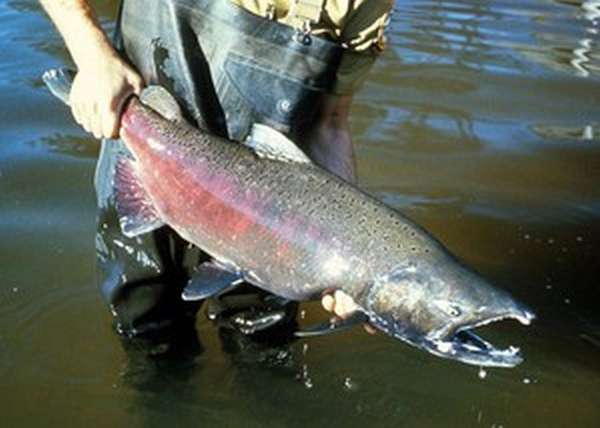
Chinook salmon is a large fish belonging to the salmon family. She may gain a lot of weight. Lives in the waters of the Pacific Ocean and rivers. Distributed in Russia (Kamchatka, Kuril Islands, Amur and Anadyr river basins), British Columbia, USA. Chinook salmon meat has health benefits. It is tasty and is an excellent product for preparing various restaurant dishes. Caviar is large and considered a delicacy.
Chinook salmon meat in cooking
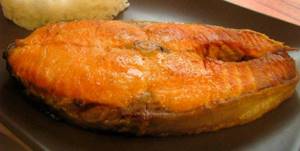
The meat of this fish is not only healthy, due to the presence of vitamins and useful elements in it, but also tasty, which allows you to prepare healthy dishes of various categories from it. Dishes prepared from lightly salted chinook salmon are extremely appreciated. As a rule, the meat is salted according to a special recipe, after which it is suitable for delicious cold appetizers, as well as for preparing salads. In addition to this cooking option, Chinook salmon meat can be marinated, smoked, grilled, etc. In America, Chinook salmon meat is cooked on heated coals or bricks, which is considered a delicacy. There are fans of dried fish, especially balyk (fillet) of this fish. When Chinook salmon meat is cooked with a high salt content, it is subsequently soaked and boiled, after which it is consumed as a snack.
How to deliciously cook Chinook salmon meat

The most delicious dish made from Chinook meat is lightly salted Chinook. To prevent the fish from losing a certain amount of its nutritional and beneficial properties, it is subjected to shock freezing. After the fish is caught, it is cut up and frozen in a special way directly on the fishing vessel, in refrigeration chambers.
Chinook salmon fried with green peas and buckwheat

Cooking steps:
- First of all, you should get rid of the scales and cut the carcass along the ridge, removing all the insides.
- The resulting fish fillet is cut into separate small pieces, salted and sprinkled with the juice of half a lemon, and also sprinkled with seasonings such as khmeli-suneli (others are also possible).
- At the next stage, the fish is marinated in the refrigerator while the buckwheat is prepared.
- Buckwheat is prepared in a frying pan by frying in vegetable oil with chopped onions. First of all, fry the onion until golden brown, after which buckwheat is added to it. All this is poured with water in a ratio of 1:3 and cooked over medium heat until cooked.
- The pickled chinook salmon is taken out of the refrigerator and fried in a frying pan on both sides, with the addition of a small amount of vegetable oil.
- Prepared buckwheat, fried fish and green pickled peas for decoration (and not only) are poured onto a plate.
Short tips
- You should not consume large amounts of Chinook salmon per day (more than 5 teaspoons) due to its high sodium content. The fact is that it binds fluid in the human body and, as a result, leads to stagnation and disruption of metabolic processes.
- Particular attention should be paid to the consumption of Chinook salmon meat or its caviar by pregnant women, as well as breastfeeding mothers. The presence of harmful substances, especially mercury, can affect the normal development of the fetus.
- Considering the fact that this fish, during its life, is capable of accumulating some harmful substances, and especially mercury, when buying it, it is better to give preference to medium and small-sized specimens.
Source: FishingDay.org

